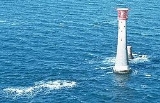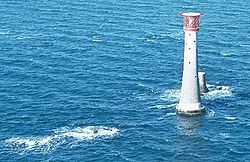
Eddystone
Encyclopedia
See also Eddystone Rock, Falklands Islands
and Eddystone, Pennsylvania
 The Eddystone, or the Eddystone Rocks, are a seaswept group of rocks situated some 9 statute miles (14 kilometres) south west of Rame Head
The Eddystone, or the Eddystone Rocks, are a seaswept group of rocks situated some 9 statute miles (14 kilometres) south west of Rame Head
in Cornwall
, England
, United Kingdom
. Formerly a treacherous hazard in the approaches to the English Channel
and the port city of Plymouth
, the rocks have played host to four iterations of the Eddystone Lighthouse
, and are still home to the current lighthouse
and the stub of its immediate predecessor.
Although the nearest point on the mainland to the Eddystone is in Cornwall, the rocks fall within the city limits of Plymouth, and hence within the county of Devon
.
There have been four lighthouses on the Eddystone Rocks. Winstanley (two versions; the second however just replaced the top of the structure), Rudyard, Smeaton and finally the Douglass Lighthouse which is the present one. When the Douglass Lighthouse was completed the people of Plymouth, grateful for the countless lives which had been saved since the introduction of the lighthouses, paid for the dismantling and reassembly of the Smeaton Lighthouse from the red rocks of Eddystone to Plymouth Hoe where it is a popular tourist attraction today.
A traditional sea-shanty "The Eddystone Light" chronicles a fictional encounter between the lighthouse keeper and a mermaid, and has been recorded by The Seekers
, the Weavers
, and Peter Paul and Mary
; it is composed of garnetiferous
gneiss
ic rock which is part of considerable underwater outcrop of mica
-schist
s and granitoid
gneisses which have not been found elsewhere in South West England
. Isotopic ages suggest that the last period of deformation was during the end of the Devonian, but their highly metamorphosed state indicates they likely have an older ancestry, a relic of earlier tectonic activity
, probably of Precambrian
age.
Eddystone Rock, Falklands Islands
Eddystone Rock is a rock and reef located to the north of Falkland Sound in the Falkland Islands. It is 44 m high. There is a lighthouse here, and it is named after a more famous one of the same name in England.-History:...
and Eddystone, Pennsylvania
Eddystone, Pennsylvania
Eddystone is a borough in Delaware County, Pennsylvania, United States. The population was 2,442 at the 2000 census.-Early history:The area at the mouth of Ridley Creek was first called "Tequirassy" by Native Americans. The land was owned by Olof Persson Stille, one of the early settlers from New...

Rame Head
Rame Head is a coastal headland, southwest of the village of Rame in southeast Cornwall, United Kingdom.-History and antiquities:The site was used for a hill fort in the Iron Age. The headland has a prominent chapel, dedicated to St Michael, accessible by a steep footpath...
in Cornwall
Cornwall
Cornwall is a unitary authority and ceremonial county of England, within the United Kingdom. It is bordered to the north and west by the Celtic Sea, to the south by the English Channel, and to the east by the county of Devon, over the River Tamar. Cornwall has a population of , and covers an area of...
, England
England
England is a country that is part of the United Kingdom. It shares land borders with Scotland to the north and Wales to the west; the Irish Sea is to the north west, the Celtic Sea to the south west, with the North Sea to the east and the English Channel to the south separating it from continental...
, United Kingdom
United Kingdom
The United Kingdom of Great Britain and Northern IrelandIn the United Kingdom and Dependencies, other languages have been officially recognised as legitimate autochthonous languages under the European Charter for Regional or Minority Languages...
. Formerly a treacherous hazard in the approaches to the English Channel
English Channel
The English Channel , often referred to simply as the Channel, is an arm of the Atlantic Ocean that separates southern England from northern France, and joins the North Sea to the Atlantic. It is about long and varies in width from at its widest to in the Strait of Dover...
and the port city of Plymouth
Plymouth
Plymouth is a city and unitary authority area on the coast of Devon, England, about south-west of London. It is built between the mouths of the rivers Plym to the east and Tamar to the west, where they join Plymouth Sound...
, the rocks have played host to four iterations of the Eddystone Lighthouse
Eddystone Lighthouse
Eddystone Lighthouse is on the treacherous Eddystone Rocks, south west of Rame Head, United Kingdom. While Rame Head is in Cornwall, the rocks are in Devon and composed of Precambrian Gneiss....
, and are still home to the current lighthouse
Lighthouse
A lighthouse is a tower, building, or other type of structure designed to emit light from a system of lamps and lenses or, in older times, from a fire, and used as an aid to navigation for maritime pilots at sea or on inland waterways....
and the stub of its immediate predecessor.
Although the nearest point on the mainland to the Eddystone is in Cornwall, the rocks fall within the city limits of Plymouth, and hence within the county of Devon
Devon
Devon is a large county in southwestern England. The county is sometimes referred to as Devonshire, although the term is rarely used inside the county itself as the county has never been officially "shired", it often indicates a traditional or historical context.The county shares borders with...
.
There have been four lighthouses on the Eddystone Rocks. Winstanley (two versions; the second however just replaced the top of the structure), Rudyard, Smeaton and finally the Douglass Lighthouse which is the present one. When the Douglass Lighthouse was completed the people of Plymouth, grateful for the countless lives which had been saved since the introduction of the lighthouses, paid for the dismantling and reassembly of the Smeaton Lighthouse from the red rocks of Eddystone to Plymouth Hoe where it is a popular tourist attraction today.
A traditional sea-shanty "The Eddystone Light" chronicles a fictional encounter between the lighthouse keeper and a mermaid, and has been recorded by The Seekers
The Seekers
The Seekers are an Australian folk-influenced pop music group which were originally formed in 1962. They were the first Australian popular music group to achieve major chart and sales success in the United Kingdom and the United States...
, the Weavers
The Weavers
The Weavers were an American folk music quartet based in the Greenwich Village area of New York City. They sang traditional folk songs from around the world, as well as blues, gospel music, children's songs, labor songs, and American ballads, and selling millions of records at the height of their...
, and Peter Paul and Mary
Geology
Eddystone rock is something of an anomaly in the geology of the South West regionCornubian batholith
The Cornubian batholith refers to the group of associated granite intrusions which underlie the south-western peninsula of Great Britain. The main exposed masses of the batholith are seen at Dartmoor, Bodmin Moor, St Austell, Carnmenellis, Land's End and the Isles of Scilly. It formed during the...
; it is composed of garnetiferous
Garnet
The garnet group includes a group of minerals that have been used since the Bronze Age as gemstones and abrasives. The name "garnet" may come from either the Middle English word gernet meaning 'dark red', or the Latin granatus , possibly a reference to the Punica granatum , a plant with red seeds...
gneiss
Gneiss
Gneiss is a common and widely distributed type of rock formed by high-grade regional metamorphic processes from pre-existing formations that were originally either igneous or sedimentary rocks.-Etymology:...
ic rock which is part of considerable underwater outcrop of mica
Mica
The mica group of sheet silicate minerals includes several closely related materials having highly perfect basal cleavage. All are monoclinic, with a tendency towards pseudohexagonal crystals, and are similar in chemical composition...
-schist
Schist
The schists constitute a group of medium-grade metamorphic rocks, chiefly notable for the preponderance of lamellar minerals such as micas, chlorite, talc, hornblende, graphite, and others. Quartz often occurs in drawn-out grains to such an extent that a particular form called quartz schist is...
s and granitoid
Granite
Granite is a common and widely occurring type of intrusive, felsic, igneous rock. Granite usually has a medium- to coarse-grained texture. Occasionally some individual crystals are larger than the groundmass, in which case the texture is known as porphyritic. A granitic rock with a porphyritic...
gneisses which have not been found elsewhere in South West England
South West England
South West England is one of the regions of England defined by the Government of the United Kingdom for statistical and other purposes. It is the largest such region in area, covering and comprising Bristol, Gloucestershire, Somerset, Dorset, Wiltshire, Devon, Cornwall and the Isles of Scilly. ...
. Isotopic ages suggest that the last period of deformation was during the end of the Devonian, but their highly metamorphosed state indicates they likely have an older ancestry, a relic of earlier tectonic activity
Orogeny
Orogeny refers to forces and events leading to a severe structural deformation of the Earth's crust due to the engagement of tectonic plates. Response to such engagement results in the formation of long tracts of highly deformed rock called orogens or orogenic belts...
, probably of Precambrian
Precambrian
The Precambrian is the name which describes the large span of time in Earth's history before the current Phanerozoic Eon, and is a Supereon divided into several eons of the geologic time scale...
age.

